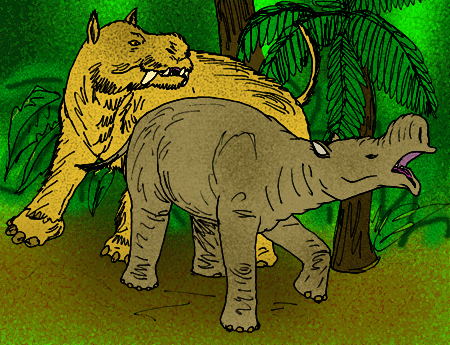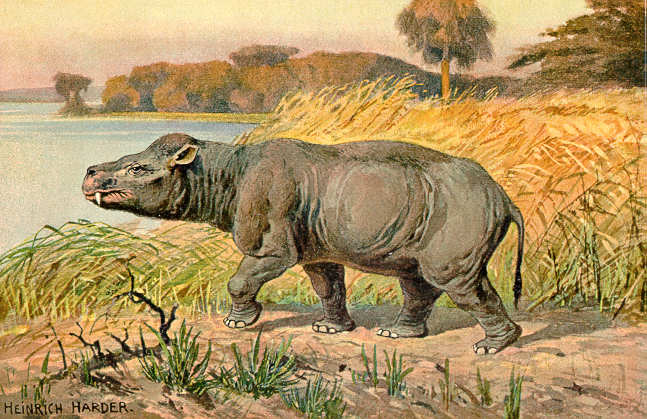|
Pantodonta
Pantodonta is an extinct suborder (or, according to some, an order) of eutherian mammals. These herbivorous mammals were one of the first groups of large mammals to evolve (around 66 million years ago) after the end of the Cretaceous. The last pantodonts died out at the end of the Eocene (around 34 million years ago). Pantodonta include some of the largest mammals of their time, but were a diversified group, with some primitive members weighing less than and the largest more than . The earliest and most primitive pantodonts, ''Bemalambda'' (with a skull probably the size of a dog) and '' Hypsilolambda'', appear in the early Paleocene Shanghuan Formation in China. All more derived families are collectively classified as Eupantodonta. The pantodonts appear in North America in the middle Paleocene, where ''Coryphodon'' survived into the middle Eocene. Pantodont teeth have been found in South America (''Alcidedorbignya'') and Antarctica, and footprints in a coal mine on Svalb ... [...More Info...] [...Related Items...] OR: [Wikipedia] [Google] [Baidu] |
Coryphodontidae
Coryphodontidae is an extinct family of pantodont mammals known from the Late Paleocene to the Middle Eocene of Eurasia and North America. The type genus ''Coryphodon'' is known from around the Paleocene-Eocene transition in Europe, western United States, northern Canada, and eastern Asia. The remaining genera are known exclusively from the middle Eocene of Asia. The coryphodontids are related to the pantolambdids. ''Coryphodon'' are large, derived pantodonts first described in the mid-19th century, but no intermediate stages leading to their unusual upper molars are known. The last known species of ''Coryphodon'' have bilophodont molars similar to later, more derived coryphodontids, and, most likely, ''Coryphodon'' is the primitive sister taxon to the remaining genera and the entire lineage (or lineages) originated from within this genus. Two coryphodontids considerably larger than ''Coryphodon'' but endemic to China, '' Asiocoryphodon'' and '' Heterocoryphodon'', have more a ... [...More Info...] [...Related Items...] OR: [Wikipedia] [Google] [Baidu] |
Alcidedorbignya
''Alcidedorbignya'' is an extinct pantodont mammal known from the Early Paleocene (Tiupampan SALMA, ) Santa Lucia Formation (, paleocoordinates ) at Tiupampa near Mizque, Cochabamba, Bolivia. Following a naming convention established by pioneering Argentine palaeontologist Florentino Ameghino (i.e. combining the first name and surname of a prominent scientist), the genus name honours French naturalist Alcide d'Orbigny. Description Estimated 25 cm head-body length and 500 grams, this was a small squirrel sized animal, terrestrial with possible scansorial habits, and either herbivorous or omnivorous. ''Alcidedorbignya'' is one of the oldest and most primitive of the pantodonts and the only pantodont genus known from South America. Not only have some scientists questioned the age of the type locality, instead advocating an Asian origin for the pantodonts, ''Alcidedorbignya'''s bare existence obscures the origins of the already enigmatic pantodonts. Taxonomic similarities indic ... [...More Info...] [...Related Items...] OR: [Wikipedia] [Google] [Baidu] |
Paleocene
The Paleocene, ( ) or Palaeocene, is a geological epoch (geology), epoch that lasted from about 66 to 56 mya (unit), million years ago (mya). It is the first epoch of the Paleogene Period (geology), Period in the modern Cenozoic Era (geology), Era. The name is a combination of the Ancient Greek ''palaiós'' meaning "old" and the Eocene Epoch (which succeeds the Paleocene), translating to "the old part of the Eocene". The epoch is bracketed by two major events in Earth's history. The K–Pg extinction event, brought on by Chicxulub impact, an asteroid impact and possibly volcanism, marked the beginning of the Paleocene and killed off 75% of living species, most famously the non-avian dinosaurs. The end of the epoch was marked by the Paleocene–Eocene Thermal Maximum (PETM), which was a major climatic event wherein about 2,500–4,500 gigatons of carbon were released into the atmosphere and ocean systems, causing a spike in global temperatures and ocean acidification. In the Pal ... [...More Info...] [...Related Items...] OR: [Wikipedia] [Google] [Baidu] |
Titanoideidae
''Titanoides'' is an extinct genus of pantodont mammal that lived in North Dakota and as far north as central Alberta. They were up to long and up to in weight, being the largest mammals of their habitat, a tropical swampland where the main predators were crocodiles. They had a bear-like appearance with huge canines, short limbs and five clawed digits; however, they were herbivores A herbivore is an animal anatomically and physiologically adapted to eating plant material, for example foliage or marine algae, for the main component of its diet. As a result of their plant diet, herbivorous animals typically have mouthpart ... and probably had traits and attributes more similar to diprotodontids. References External links *Ferae Past and Present (Phylogenetic tree) at Okapiland Pantodonts Paleocene mammals Clawed herbivores Cenozoic mammals of North America Fossil taxa described in 1917 Prehistoric mammal genera {{Paleo-mammal-stub ... [...More Info...] [...Related Items...] OR: [Wikipedia] [Google] [Baidu] |
Barylambda
''Barylambda'' (Greek: "heavy" (baros), "lambda" (lambda) in a reference to larger size than that of '' Pantolambda'') is an extinct genus of pantodont mammal from the middle to late Paleocene, well known from several finds in the Wasatchian ( NALMA classification) DeBeque Formation of Colorado and the Clarkforkian Wasatch Formation to Tiffanian Fort Union Formation in Wyoming. Three species of ''Barylambda'' are currently recognized. The creature likely lived a life similar to that of a modern tapir, browsing on foliage and soft vegetation. ''Barylambda'' seems to have been quite successful for an early pantodont, though eventually it seems to have been replaced in its ecosystem by other pantodonts, such as ''Coryphodon''. Description In life, ''Barylambda'' probably resembled a large ground sloth, with a small head and long, well-developed tail and bear-like legs. The length was about with a weight around , about the size of a pony. ''Barylambda'' was large even for a pan ... [...More Info...] [...Related Items...] OR: [Wikipedia] [Google] [Baidu] |
Bemalambdidae
Bemalambdidae is an extinct family of pantodont mammals known from Early and Middle Paleocene of China. Description The bemalambdids are, along with '' Harpyodus'' and ''Alcidedorbignya'', the most primitive pantodonts. ''Hypsilolambda'' is known only from a skull and teeth, but ''Bemalambda'' is known from complete cranial and postcranial specimens and the best preserved mammal from Shanghuan. It was dog-sized (a large animal for its era) and omnivorous. Both genera have dilambdodont upper premolars (W-shaped crests on the crowns), one of the characteristics of pantodonts, but their upper molars, unlike in later pantodonts, are almost zalambdodont (V-shaped crests) and transversely elongated with the paracone and metacone (cusp) appressed or connated. On p3-M3, there is a large buccal platform on the crowns, the stylar shelf. An exterior indentation on the buccal side, the ectoflexus, is very deep. The lower cheek teeth are easily recognizable as pantodont. The bemalamb ... [...More Info...] [...Related Items...] OR: [Wikipedia] [Google] [Baidu] |
Dental Formula
Dentition pertains to the development of teeth and their arrangement in the mouth. In particular, it is the characteristic arrangement, kind, and number of teeth in a given species at a given age. That is, the number, type, and morpho-physiology (that is, the relationship between the shape and form of the tooth in question and its inferred function) of the teeth of an animal. Animals whose teeth are all of the same type, such as most non-mammalian vertebrates, are said to have '' homodont'' dentition, whereas those whose teeth differ morphologically are said to have '' heterodont'' dentition. The dentition of animals with two successions of teeth (deciduous, permanent) is referred to as '' diphyodont'', while the dentition of animals with only one set of teeth throughout life is ''monophyodont''. The dentition of animals in which the teeth are continuously discarded and replaced throughout life is termed ''polyphyodont''. The dentition of animals in which the teeth are set in s ... [...More Info...] [...Related Items...] OR: [Wikipedia] [Google] [Baidu] |
Barylambdidae
Barylambdidae is an extinct family of pantodont Pantodonta is an extinct suborder (or, according to some, an order) of eutherian mammals. These herbivorous mammals were one of the first groups of large mammals to evolve (around 66 million years ago) after the end of the Cretaceous. The last ... mammals from North America. References Pantodonts Paleogene mammals of North America Prehistoric mammal families {{Paleo-mammal-stub ... [...More Info...] [...Related Items...] OR: [Wikipedia] [Google] [Baidu] |
Bemalambda
''Bemalambda'' is an extinct mammal, belonging to the pantodonts. It lived in the lower-middle Paleocene (about 63–58 million years ago) and the fossil remains have been found in China. Description It was a medium-size animal, and could reach the size of a large dog. The body was strong, the tail was short and the legs were strong and muscular. The skull was short and low, with a broad muzzle, swollen zygomatic processes, and a very small skull. The temporal fossae were deep, the sagittal crest prominent, and the coronoid process on the mandible was very high; these characteristics indicate a more developed temporal musculature (useful for chewing) than that of the subsequent pantodonts. Like all pantodonts, ''Bemalambda'' had upper premolars with V-shaped ectolofi; the upper molars, however, had a transverse structure, almost zalambdodonte, with closely paired paracone and metaconus, and did not possess the dilambdodont W-shaped structure like the typical pantodonts. The ... [...More Info...] [...Related Items...] OR: [Wikipedia] [Google] [Baidu] |
Coryphodon
''Coryphodon'' (from Greek κορῦφὴ, "point", and ὀδοὺς, "tooth", meaning ''peaked tooth'', referring to "the development of the angles of the ridges into points n the molars") is an extinct genus of pantodonts of the family Coryphodontidae. ''Coryphodon'' was a pantodont, a member of the world's first group of large browsing mammals. It migrated across what is now northern North America, replacing ''Barylambda'', an earlier pantodont. It is regarded as the ancestor of the genus ''Hypercoryphodon'' of Late Eocene Mongolia. ''Coryphodon'' is known from many specimens in North America and considerably fewer in Europe, Mongolia, and China. It is a small to medium-sized coryphodontid who differs from other members of the family in dental characteristics. Description At about at shoulder height and in body length, ''Coryphodon'' is one of the largest-known mammals of its time. The creature was very slow, with long upper limbs and short lower limbs, which were needed ... [...More Info...] [...Related Items...] OR: [Wikipedia] [Google] [Baidu] |





